Fume hoods are essential equipment for industries that require handling of hazardous chemicals or materials. Get to know more about them here

Those who work in companies or industries that involve handling and working with hazardous chemicals must always use the best safety equipment they can find. Apart from the obvious need for looking after the safety and well-being of your staff, serious penalties can result if your organization doesn’t use the proper safety equipment.
That brings us to discuss the importance of finding a suitable fume hood for your company and staff. The fume hood is just one of many pieces of safety equipment you will need if your company handles dangerous substances that emit vapours, odours, or tiny particles.
In this article, Canadian Occupational Safety delves into the importance of the fume hood. We’ll provide answers to questions like:
- what is a fume hood?
- how do you use a fume hood?
- what is the purpose of a fume hood?
- how much is a fume hood in canada?
We’ll shed light on these and other important topics and more in this article.
What is a fume hood and what is it for?
A fume hood is a ventilated enclosure. This is designed to not only contain hazardous fumes, vapours, odours, or particles but also to ventilate them and keep them safely away from workers. These are the equipment’s primary functions:
1. Provide protection from toxic fumes
Fume hoods create an enclosed environment and a physical barrier that can safely contain hazardous fumes, vapours, or dust particles. If you have laboratory workers who must handle dangerous substances, this equipment can minimize the risk of exposure to harmful vapours or particles.
2. Make it safer to work with toxic or hazardous substances
A fume hood can lessen the risk of exposure to harmful odours, vapours, dangerous splashes, or even minor explosions or fires.
3. Prevent widespread contamination
As it is enclosed, this piece of important safety equipment can also isolate these harmful materials from leaking out and contaminating other areas of the workplace.
Examples of applications for fume hoods
The equipment is used in a variety of industries and find useful applications in activities such as:
- Aerospace manufacturing: Hoods are useful for protecting workers who must do surface finishing with nitric acid. This is a very important process in aerospace engineering and manufacturing, as this increases the corrosion resistance of certain parts.
- Art conservation: When it comes to restoring priceless pieces of art, the right hood can protect professional art restorers from the harmful vapours of strong solvents and cleaning chemicals.
- Forensic laboratories: Chemical fume hoods are useful for forensic analysis in criminal investigations. Examining pieces of evidence can involve using powerful solvents or other dangerous chemicals to find traces of substances that are important to solving cases. The equipment can protect forensic lab staff and preserve evidence.
Fume hoods are an essential part of your team’s PPE. Find out what other types of protective gear your business needs in this essential guide to personal safety equipment. This guide includes downloadable checklists of the PPE requirements for each industry.
How do fume hoods work?
A fume hood is typically a large, ventilated enclosure that has powerful fans that capture and vent away harmful vapours or dust particles emitted by hazardous substances. Oftentimes, the equipment is installed in buildings or facilities with massive exhaust fans to draw the fumes through filters before venting them out.
It’s important to note that some fume hoods may have carbon filters instead of HEPA filters. Ductless fume hoods may have a main carbon filter, and a secondary high-efficiency particulate air (HEPA) filter at their exhaust section.
A typical unit is equipped with a movable front sash and an interior baffle. The front sash can move vertically, horizontally or a combination of both, depending on its design. Closing the sash protects the user by acting as a physical barrier between the worker and the materials they are working on.
Meanwhile, the slots and vents contained within the unit direct the airflow and are usually adjustable to allow for an even flow. Proper use and maintenance of these hoods entails ensuring that these baffles remain unobstructed by other equipment or excess filtered material.
The airfoil, or beveled frame around the hood face, allows for even air flow by eliminating sharp curves, thereby reducing turbulence.
Here’s a short video that shows what a typical fume hood looks like. The video also demonstrates how to properly use the front sash and what is usually done if there’s an unexpected splash or spill of hazardous material:
Types of fume hoods
When looking for the appropriate fume hood, you can choose from different types that vary in terms of dimensions, configurations, and materials they can handle. Consider the type of unit that suits your company’s needs and can provide the utmost safety for your staff.
1. Bench-top fume hood
This is a compact hood placed on top of a work surface and is raised 36 inches off the floor. This is common and more suitable for laboratory work. Bench-top hoods often need their own supporting base cabinet and exhaust blower.
2. Floor-mounted fume hood
Also known as walk-in fume hoods, this is a large unit that is installed from the floor up. They look more like small rooms and are ideal for working with oversized equipment or tools while handling hazardous materials.
3. Double-faced fume hood
With two entrances, the double-faced hood allows for 360-degree views. This unit is often used in organizations that do demonstrations or for educational purposes. It is ideal for classrooms and teaching activities.
4. Portable fume hood
These units are lightweight, ductless, and easily transportable. Also called ductless fume hoods, they have a built-in carbon filtering system and don’t need ductwork. These are ideal for labs that need more portability, flexibility, and cost efficiency. However, they are not ideal for tasks that involve handling highly hazardous materials. These units require regular maintenance.
5. Constant airflow volume (CAV) hood
As its name implies, this type of hood uses a consistent airflow for stable performance and does not require rebalancing. CAV hoods can be used in some laboratories but cannot deliver on variable airflow requirements.
6. Variable air volume (VAV) hood
In this unit, the volume of air or exhaust flowrate varies as the front sash is raised or lowered. With its ability to vary the airflow, this type of hood is more versatile and can be used for a wider range of industries and applications.
7. Reduced air volume (RAV) hood
The RAV hood is designed to use less energy by partially blocking its bypass opening. RAV hoods are an excellent choice for organizations that have laboratories that require specific tasks with unchanging parameters.
8. Acid digestion fume hood
This is a specific type of hood designed to enable staff to handle volatile and highly corrosive acids safely. To work with acids, these hoods have protective liners and are made of acid-resistant materials.
9. Radioisotope fume hood
These hoods are specifically designed to handle radioactive materials, so they are typically lead-lined to protect its users. Radioisotope hoods can do heavy-duty work handling hazardous materials in hospitals and nuclear facilities.
Canadian rules & regulations governing fume hoods
There are some rules and regulatory bodies that prescribe the appropriate requirements for fume hoods’ safe and proper use, installation and maintenance. Here are the guidelines set by some safety regulators in Canada:
1. Canada Occupational Health and Safety Regulations (COHSR)
This organization provides for the essential safety standards for laboratory environments, and that includes fume hoods. The COHSR’s key regulations and safety requirements include:
- Airflow standards: the average face velocity of a fume hood to be deemed safe and sufficient for laboratory use is a range of between 0.4 metres per second (80 feet per minute) to 0.6 metres per second (120 feet per minute).
- Design and operational requirements: fume hoods should be connected to local exhaust ventilation systems. This is to ensure that the filtered, contaminated air is drawn safely away from lab workers.
- Maintenance requirements: Routine inspections and maintenance should be conducted to ensure compliance with safety and performance standards apart from avoiding potential penalties.
2. MD1528-2013 guidelines
This document sets out specific guidelines on a fume hood’s design and operational criteria, which include:
- Testing and certification: The unit's construction should meet testing criteria. They must also comply with local and state sanitation and safety standards.
- Design requirements: These outline specific standards relating to constant air volume bypass, variable air volume designs, and effective air capture.
3. ANSI/ASHRAE and ANSI/AIHA standards
Fume hoods in Canada must also comply with related American National Standards Institute (ANSI) standards, specifically:
- ANSI/ASHRAE 110-1995: This standard outlines the parameters for acceptable performance, measuring face velocity and airflow visualization.
- ANSI/AIHA Z9.5-2012: This standard outlines the safety and effectiveness performance requirements.
4. CSA Standards
The Canadian Standards Association (CSA) has safety requirements outlined in CSA Z316.5:20. These standards are meant to ensure that the unit’s design effectively meets safety standards for its users and maintenance personnel.
5. University safety protocols
If a fume hood is to be placed and used within a university campus, that institution should have specific guidelines and regulations regarding the equipment's use and safety. University safety protocols can encompass the following:
- User training: those assigned to use the fume hoods must be trained in their proper use and maintenance.
- Operational safety: to further ensure the safety of fume hoods on campus, comprehensive manuals detailing safe use and proper maintenance should be provided to personnel.
Fume hoods vs biological safety cabinets – what's the difference?
As you search for fume hoods, you may come across another piece of safety equipment – biological safety cabinets. Some vendors or manufacturers may lump these types of equipment together. This can happen when they refer to biological safety cabinets as technically a form of fume hood.
When finding the right safety equipment for your lab or work area, it’s very important to delve deeper and be wary of the subtle but crucial differences of these seemingly similar gas-tight enclosures.
Fume hoods protect users from inhaling toxic emissions from lab experiments by drawing the harmful air away. The contaminated air is then directed into a ducted system and expelled outside the facility. Note that hoods typically do not have any HEPA filters and rely on dilution to dissipate harmful vapours or dust.
Meanwhile, biological safety cabinets protect its users, the environment, and the materials handled from exposure to infectious agents and cross-contamination. Biosafety cabinets, especially the class III types, can offer the highest levels of protection with their built-in HEPA filters. These filters trap biohazards and remove contaminants from the air. Biosafety cabinets do not exhaust air outside, but release filtered air into the same room instead.
Examples of fume hoods
Here are some units you can find on the market today. Do your due diligence and make sure to choose a reputable brand that complies with Canadian safety standards while meeting your needs and budget.
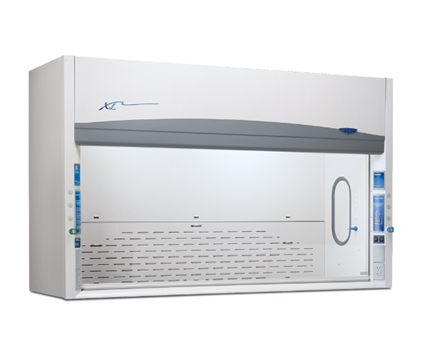
1. Labconco Protector XL Benchtop Laboratory Hood
The Protector XL Benchtop Laboratory Hood is a general chemistry hood of superior design and flexibility of use. This is part of a range that can be had in widths from 3 to 16 feet to meet a variety of installation and application types. This benchtop hood can operate at face velocities as low as 60 fpm and meets the SEFA-1 standard of a low-velocity, but high-performance hood.
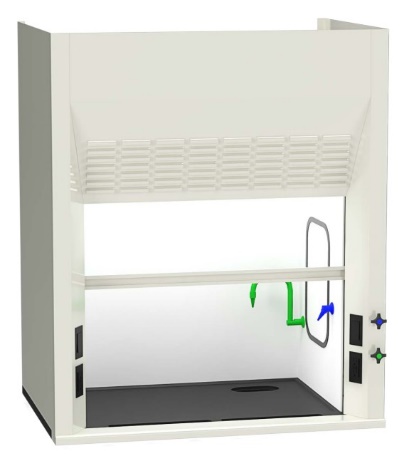
2. Air Master Eliminator 100
Air Master is a US manufacturer based in Michigan and has been manufacturing laboratory fume hoods since 1975. Their decades-long expertise is evident in the EH-100 series airfoil-type model. Its flush-mount radiused airfoil offers minimal turbulence and increased performance. Like the exterior of the hood, the airfoil is made from chemical-resistant, powder-coated, 16-gauge cold rolled steel.
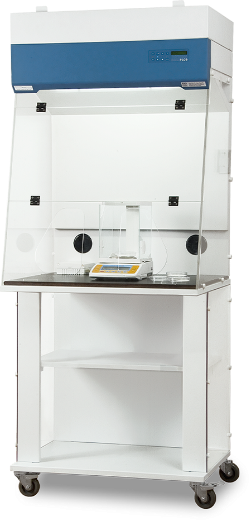
3. ESCO Powdermax
This is a fume hood from ESCO, a reputable lab equipment outfitter in Taiwan. This particular ductless model is ideal for handling powdered chemicals and is equipped with a HEPA filter. It features a phenolic worktop surface to minimize vibrations and provide a stable work environment.
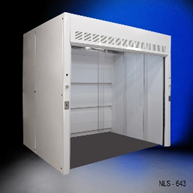
4. TopAir Systems Ductless Floor-Mounted fume hood
This floor-mounted hood from TopAir features a large front opening designed to contain large, heavy, or tall equipment. The hood itself provides a safe environment for lab staff working with a variety of chemicals. Made from sturdy polypropylene, this unit offers high chemical resistance. Its 5mm-thick front sash provides safety and viewing convenience.
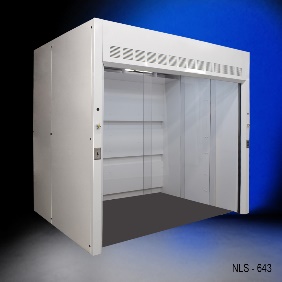
5. Fisher American Walk-In Fume Hood (NLS-643)
The NLS-643 walk-In fume hood by Fisher American consists of a durable 6x 6 feet structure that’s designed for practical lab use. With its generous workspace, this high-quality hood prioritizes functionality. It has a curtain sash and baffles for safe particle exhaust, ensuring a secure lab environment. Service valves, LED lighting, a user-friendly switch, and an outlet come standard. Optional additions like a cup sink, extra valves, and outlets are available for this model.
Important safety reminders
For a fume hood to effectively protect workers as they handle toxic materials, it must be used properly and combined with other safety measures. Even with proper use, the equipment may not confer complete protection for workers.
When handling extremely hazardous materials, you must also supply workers with the PPEs and other protective gear or equipment necessary to further miminize the risk of exposure or injury. And remember to prioritize your workers’ safety when choosing a fume hood or any other piece of equipment. Penalties and fines for OHSA safety violations are very harsh, especially if you are in Ontario.
Did you find this guide on fume hoods helpful? Let us know your thoughts in the comments.





